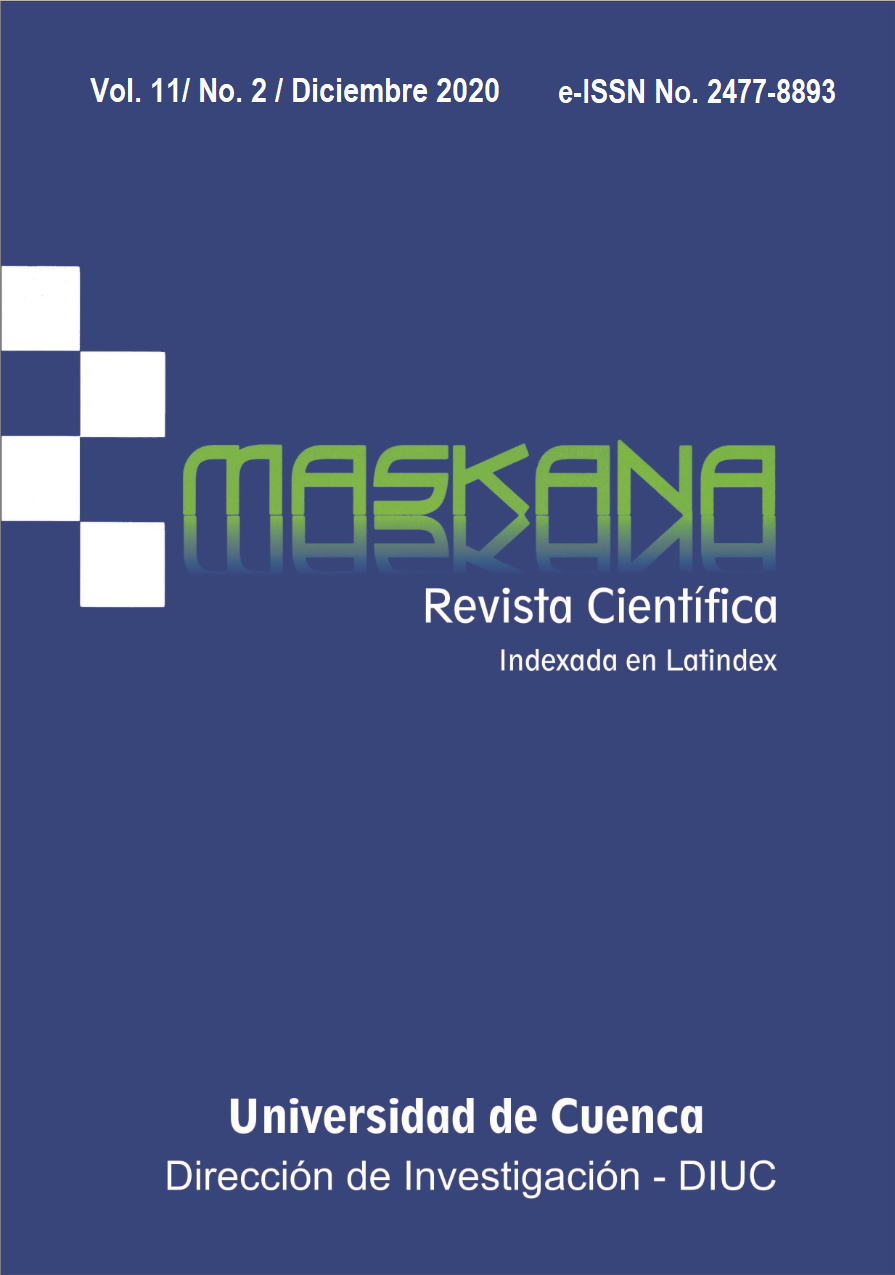Análisis de las estrategias de sustento de los campesinos en la cuenca del Paute de Ecuador
DOI:
https://doi.org/10.18537/mskn.11.02.07Palabras clave:
Agricultura, campesinos, medios de vida, hogar, tipología, AndesResumen
El artículo analiza la forma de sustento de los campesinos en el área rural de tres parroquias de la cuenca del Paute en Ecuador. En primer lugar, el artículo presenta los datos empíricos recopilados de los sitios de estudio, respectivamente Pichacay en la parroquia Santa Ana, Caldera en la parroquia Javier Loyola y Llavircay en la parroquia Rivera. Aplicando el marco de interpretación de Chayanov y van der Ploeg, se podrían distinguir tres tipos de hogares campesinos, basados en sus formas organizativas específicas de producir y reproducir sus medios de vida. El artículo concluye que es necesario un análisis más profundo del arte campesino de la agricultura, particularmente en su balance central de estar condicionado y vinculado y resistir a la economía capitalista.
Descargas
Métricas
Citas
Bidogeza, J., Berentsen, P., De Graaff, J., & Oude Lansink, A. (2009). A typology of farm households for the Umutara Province in Rwanda. Food Security, 1, 321-35.
CGPaute. (2006). Dinámicas socio-económicas rurales en la cuenca del Paute. Consejo de Gestión de Aguas de la Cuenca del Paute. Proyecto de Desarrollo de la Cuenca del Río Paute, Ecuador.
Chayanov, A. (1974). La organización de la unidad económica campesina. Ediciones Nueva Visión, Buenos Aires, 1974. Editada en ruso en 1925 por el Instituto de Investigación Científica de Economía Agrícola de Moscú.
Ellis, F. (1993). Peasant economics: Farm households and agrarian development. Cambridge, UK: University Press.
Husson, F., Josse, J., Lê, S., & Mazet, J. (2009). FactoMineR: Multivariate exploratory data analysis and data mining with R. R package version 1.12. Available at http://factominer.free.fr.
Instituto Nacional de Estadística y Censos (INEC) (2010). VII Censo de Población y V de Vivienda. Resultados definitivos, provincias del Azuay y Cañar. INEC, Quito, Ecuador.
Instituto Nacional de Estadística y Censos (INEC) (2012). Clasificación Nacional de Actividades
Económicas (CIIU Rev. 4.0). INEC, Quito, Ecuador.
Jokisch, B. (2002). Migration and agricultural change: The case of smallholder agriculture in highland Ecuador. Human Ecology, 30, 523–550.
Jokisch, B., & Lair, B. (2002). One last stand? Forests and change on Ecuador's eastern cordillera. Geographical Review, 92(2), 235-256. https://doi.org/10.1111/j.1931-0846.2002.tb00006.x
Laurent, C., van Rooyen, J., Madikizela, P., Bonnal, P., & Carstens, J. (1998). Household typology for relating social diversity and technical change: The example of rural households in the Khambashe area of the Eastern Cape Province of South Africa. Agrekon, 38(S1), 190-208. https://doi.org/10.1080/03031853.1999.9524914
Martin, J. (2005). Los factores definitorios de los grandes grupos de edad de la población: tipos, subgrupos y umbrales. Geo Crítica / Scripta Nova. Revista electrónica de geografía y ciencias sociales, IX(190). Available at http://www.ub.es/geocrit/sn/sn-190.htm
Perret, S., Anseeuw, W., & Mathebula, F. (2005). Poverty and livelihoods in rural South Africa: Integrating diversity and dynamics of livelihoods. Case studies in Limpopo. Report on theme 1: Strategies for poverty alleviation and food security. Pretoria, South Africa: Post-Graduate School for Agriculture and Rural Development, University of Pretoria.
Perret, S., Carstens, J., Randela, R., & Moyo, S. (2000). Activity systems and livelihoods in the Eastern Cape Province rural areas (Transkei): Household typologies as socio-economic contributions to a LandCare project. Working Paper 2007-07. Pretoria, South Africa: University of Pretoria / CIRAD, CIRAD Tera num. 2000/28.
Perret, S., & Kirsten J. (2000). Studying the local diversity of rural livelihoods systems: An application of typological techniques for integrated rural development support in the Eastern Cape (South Africa). Working Paper 2005-05. Pretoria: Department of Agricultural Economics, Extension and Rural Development, University of Pretoria.
R Development Core Team (2007). R: A language and environment for statistical computing. R Foundation for Statistical Computing, Vienna, Austria. Available at http://www.R-project.org.
Vandenberghe, J., & Vanacker, V. (2008). Editorial: Towards a system approach in the study of river catchments. Geomorphology, 98, 173-175. https://doi.org/10.1016/j.geomorph.2007.01.025
Vanegas, R., Demoulin, F., & Henry, S. (2012). Report on the field survey performed on Pichacay, Caldera and Llavircay study areas, Paute catchment, Ecuador. Technical report. Faculty of Agricultural Sciences (University of Cuenca, Ecuador) and Department of Geography (University of Namur, Belgium).
van der Ploeg, J. D. (2013). Peasants and the art of farming: A Chayanovian manifesto. (Agrarian Change and Peasant Studies Series; No. 2). Fernwood. Available at https://edepot.wur.nl/424204
Weiss (2007). In J. D. van der Ploeg (2018). The new peasantries. London, UK: Routledge, https://doi.org/10.4324/9781315114712
Whatmore, S. (1994) Farm household strategies and styles of farming: Assessing the utility of farm typologies. In J. D. van der Ploeg & A. Long (Eds.) Born from within: practice and perspectives of endogenous rural development, pp. 31-37. Assen, the Netherlands: Van Gorcum.
Descargas
Publicado
Cómo citar
Número
Sección
Licencia
Copyright © Autors. Creative Commons Attribution 4.0 License para cualquier artículo enviado a partir del 6 de junio de 2017. Para los manuscritos presentados anteriormente, se utilizó la licencia CC BY 3.0.
![]()
Usted es libre de:
 |
Compartir — compartir y redistribuir el material publicado en cualquier medio o formato. |
 |
Adaptar — combinar, transformar y construir sobre el material para cualquier propósito, incluso comercialmente. |
Bajo las siguientes condiciones:
 |
Atribución — Debe otorgar el crédito correspondiente, proporcionar un enlace a la licencia e indicar si se realizaron cambios. Puede hacerlo de cualquier manera razonable, pero de ninguna manera que sugiera que el licenciador lo respalda a usted o a su uso. |
| Sin restricciones adicionales: no puede aplicar términos legales o medidas tecnológicas que restrinjan legalmente a otros a hacer cualquier cosa que permita la licencia. |
Mayor información sobre este acuerdo de autoría y licencia, transferencia de derechos o solicitudes de reproducción, pueden ser consultados en este enlace.









